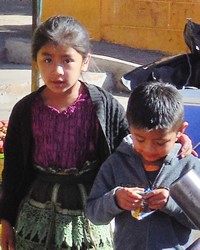Cakchiquel, Santa Maria de Jesus in Guatemala

Photo Source:
Anonymous
|
Send Joshua Project a map of this people group.
|
| People Name: | Cakchiquel, Santa Maria de Jesus |
| Country: | Guatemala |
| 10/40 Window: | No |
| Population: | 39,000 |
| World Population: | 39,000 |
| Primary Language: | Kaqchikel |
| Primary Religion: | Christianity |
| Christian Adherents: | 97.00 % |
| Evangelicals: | 9.00 % |
| Scripture: | Complete Bible |
| Ministry Resources: | Yes |
| Jesus Film: | Yes |
| Audio Recordings: | Yes |
| People Cluster: | Central American Indigenous, other |
| Affinity Bloc: | Latin-Caribbean Americans |
| Progress Level: |
|
Introduction / History
Cakchiquel are among the Mayan-based tribes in Guatemala. The Mayan civilization was severely weakened by the time of the Spanish conquest. Cakchiquels sometimes allied themselves with the Spaniards against rival tribes but ultimately became Spanish subjects.
All 11 Cakchiquel subgroups are represented in Guatemala, but some also live in Mexico or the United States. Those who moved out of the country did so either because of political oppression in the 1970s or to pursue better job opportunities.
What Are Their Lives Like?
Most Santa Maria de Jesus Cakchiquels are subsistence farmers. Their main crops include maize, black beans, chilis, and various squashes. Chicken and eggs are part of their diet.
Some Cakchiquels earn their living through the tourist industry. They sell trinkets, hand-made clothes, souvenirs, and other goods. Among themselves, they use the barter system, but not with tourists.
Most of their festivals have their roots either in ancient Mayan traditions, Roman Catholicism, or a blend of both. The Feast of the Virgin of the Assumption honors their patron saint. They honor him with music, dancing, and processions. All Saints Day honors their ancestors. They conduct agricultural rituals to thank the earth and ask for a good harvest.
What Are Their Beliefs?
The Santa Maria de Jesus Cakchiquels are predominantly Roman Catholic, with a minority of Evangelicals. There is a remnant of their pre-Columbian religious beliefs that involved multiple gods. Unknown to outsiders, their Catholic masses contain syncretistic practices.
What Are Their Needs?
Cakchiquels need better ways to earn a living. Subsistence farming leaves them in poverty. Christians can honor the Lord among them by teaching them valuable urban-based skills. They lack access to quality education and electricity.
Prayer Points
Pray that God will give Santa Maria de Jesus Cakchiquel farmers an abundant harvest as a testimony of His love and power.
Pray that they may put all their hope and faith in Jesus Christ.
Pray that soon Cakchiquels will become Christ s ambassadors throughout Latin America.
Pray for Santa Maria de Jesus Cakchiquels to receive the training they need to thrive in a modern economy.